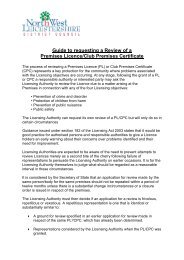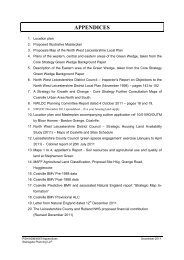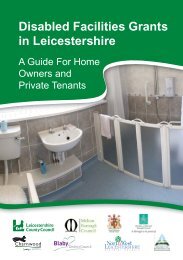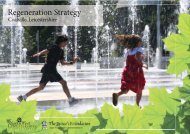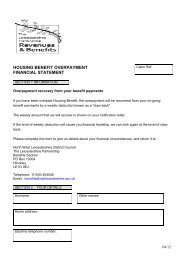Housing Strategy 2011-2015 - North West Leicestershire District ...
Housing Strategy 2011-2015 - North West Leicestershire District ...
Housing Strategy 2011-2015 - North West Leicestershire District ...
You also want an ePaper? Increase the reach of your titles
YUMPU automatically turns print PDFs into web optimized ePapers that Google loves.
Better Homes, Better Lives<br />
<strong>Housing</strong> <strong>Strategy</strong><br />
<strong>2011</strong>-<strong>2015</strong><br />
April <strong>2011</strong>
Page 1<br />
<strong>Housing</strong> <strong>Strategy</strong>
Page 2<br />
Executive Summary<br />
Introduction<br />
Our housing strategy describes how we, the <strong>North</strong> <strong>West</strong> <strong>Leicestershire</strong> Strategic <strong>Housing</strong> Partnership,<br />
intend to meet the housing needs and aspirations of our residents, making the best use of all the<br />
resources we have at our disposal and contributing to our vision for the district.<br />
We think that a clear direction and leadership is needed at a time of uncertainty and our strategy is<br />
based on an understanding of what people need and want in <strong>North</strong> <strong>West</strong> <strong>Leicestershire</strong>, across all<br />
tenures and household circumstances. Residents tell us that affordable decent housing is the fourth<br />
most important factor in making somewhere a good place to live.<br />
Our vision<br />
We want <strong>North</strong> <strong>West</strong> <strong>Leicestershire</strong> to be a place where people and businesses feel they belong<br />
and are proud to call home<br />
Our housing strategy will contribute to this. We want to see:<br />
1. Homes for all<br />
2. Healthy homes<br />
3. Content and confident communities<br />
4. Fair and equal access to housing<br />
In deciding how we will achieve these outcomes we have considered how action can improve<br />
health and wellbeing, and contribute to a sustainable and resilient economy. We also aim to support<br />
individuals and communities so that they are more able to contribute to society, to take control of the<br />
services they receive and the choices they make, and to hold us to account.<br />
How we have developed the strategy<br />
This strategy has been developed by a partnership of <strong>North</strong> <strong>West</strong> <strong>Leicestershire</strong> <strong>District</strong> Council,<br />
<strong>Leicestershire</strong> County Council, housing associations working in the area, <strong>Leicestershire</strong> and Rutland<br />
Probation Trust, private developers and voluntary and community sector organisations.<br />
This Partnership will be responsible for this strategy and making sure it is delivered.<br />
To get to this point we carried out research and analysis, workshops and discussions and we<br />
considered what residents and customers of housing services say is important. The evidence we<br />
based our decisions on can be found here http:// www.nwleics.gov.uk/pages/housing_strategy<br />
We have an annual action plan that describes how we will deliver this strategy in more detail. This<br />
also makes it clear where we would like input from local residents and other interested parties. This<br />
can be viewed here http:// www.nwleics.gov.uk/pages/housing_strategy<br />
For further information about this strategy, the action plan and opportunities for involvement, or in<br />
relation to housing matters in general please contact Sue Hallam at <strong>North</strong> <strong>West</strong> <strong>Leicestershire</strong> DC;<br />
tel: 01530 454 612 or email: sue.hallam@nwleicestershire.gov.uk.<br />
<strong>2011</strong>-<strong>2015</strong>
Page 3<br />
The challenges we will overcome<br />
We identified a number of challenges that we need to overcome if we want to achieve our vision and<br />
meet housing need and aspirations.<br />
Key challenges<br />
1. There is a limited choice of housing available to people in <strong>North</strong> <strong>West</strong> <strong>Leicestershire</strong>,<br />
including a lack of affordable homes<br />
2. Improvement is needed in the condition of existing homes in both the social and private<br />
housing sector, particularly to improve health and wellbeing, The private rented sector<br />
will need to play a greater role in the future in meeting housing needs as other options<br />
are limited.<br />
3. There is an increasingly older population, and people are living longer but not necessarily<br />
with healthier lives. Other households also have additional health needs which impact on<br />
their housing requirements.<br />
4. The economic downturn, government spending plans and welfare reform are expected to<br />
reduce household income, increase the need for affordable housing and increase<br />
vulnerability – but our collective capacity to respond is also reducing<br />
5. There are a number of areas within the district with concentrations of issues, and there’s<br />
a danger these areas will not improve, or will get worse<br />
Our outcomes in more detail and priorities for action<br />
1. We will have ‘homes for all’ when<br />
• New homes are suitable to meet different aspirations and needs, well-designed<br />
and sustainable<br />
– Affordable housing is available in rural communities<br />
– Property sizes and types reflect needs and aspirations including smaller<br />
accommodation and bungalows<br />
– Supported housing is available<br />
– Gypsies, travellers and travelling showpeople have access to good quality<br />
site provision<br />
• The best use is made of existing housing, including empty homes and under-occupied homes<br />
We will build on:<br />
• Our Affordable <strong>Housing</strong> Supplementary Planning Document which requires a choice of homes<br />
in new developments and we ask for a contribution of new affordable homes from developers<br />
• Our Local Investment Plan for affordable homes which prioritises settlements with populations<br />
under 3,000, and the support we provide to develop rural homes (34 new homes in <strong>2011</strong>/12)<br />
• Our success in securing funding for new homes (£11.3 million in 2008-10) and housing<br />
support. The Council also made available £670,000 worth of land to enable new homes to<br />
be built.<br />
• Our Empty Property <strong>Strategy</strong> which aims to bring long term empty properties back into use.<br />
<strong>Housing</strong> <strong>Strategy</strong>
Page 4<br />
Between now and <strong>2015</strong> we will:<br />
• Develop and implement flexible planning and development processes to enable new homes<br />
• Identify and implement alternative delivery mechanisms for the delivery of rural<br />
affordable housing<br />
• Work with housing associations to inform and implement the Homes and Communities<br />
Agency’s affordable rent programme in the district<br />
• Implement a local housing needs survey programme and use these to inform our plans<br />
• Look at the options for the barriers to development presented by the River Mease, and<br />
take action<br />
• Review all council owned land to identify the potential for house building<br />
• Introduce a policy within the Core <strong>Strategy</strong> to meet the needs of Gypsies, Travellers and<br />
Travelling Showpeople<br />
• Develop an under-occupation incentive scheme, linked to the proposed local authority<br />
strategic tenancy policy<br />
2. We will have ‘healthy homes’ when<br />
• There are warm, safe and well maintained homes<br />
• There are well-managed homes<br />
• Homes are flexible to meet changing needs and that people are able to move if their<br />
needs change<br />
• Neighbourhood environments support a good quality of life<br />
We will build on:<br />
• Our Landlords Exchange Forum where issues of private sector housing management<br />
are covered<br />
• Our work to monitor and improve housing conditions in the privately owned sector<br />
• The Council’s Green Footprint Challenge which aims to change the way we think about<br />
our local environment eg, by encouraging sustainable urban design<br />
• Work with the new Leicester and <strong>Leicestershire</strong> Enterprise Partnership to achieve a low<br />
carbon economy ‘where homes and jobs are aligned’<br />
• Affordable housing design standards which require new homes to have a minimum impact<br />
on energy use and reduce harmful carbon emissions<br />
• The Council’s current policy in relation to its own housing stock to exchange failing solid<br />
fuel appliances with gas fired alternatives where mains service provision lends the opportunity.<br />
<strong>2011</strong>-<strong>2015</strong>
Page 5<br />
Between now and <strong>2015</strong> we will:<br />
• Introduce a Supplementary Planning Document to enable healthy homes<br />
and neighbourhoods<br />
• Improve the condition of council owned homes to achieve the decent standard by <strong>2015</strong><br />
• Improve the condition of homes in the private sector, identifying non-decency through surveys<br />
and reports from residents, working with landlords and homeowners and taking enforcement action<br />
• Improve affordable warmth, improving access to affordable energy supplies for council tenants<br />
and advising private sector landlords and tenants of opportunities to improve<br />
their homes<br />
• Improve the Disabled Facilities Grant programme, working with other authorities<br />
and organisations and updating the district policy so that it is in line with the County<br />
Council policy<br />
3. We will have ‘content and confident communities’ when<br />
• More people able to afford a wider range of quality housing options<br />
• Communities welcome and support people living in their neighbourhoods<br />
• There is a wider understanding of the housing options open to people to maintain<br />
or improve their housing circumstances<br />
We will build on:<br />
• Our approach to enabling employment through our planning applications process<br />
• Our new choice based lettings system with the 6 other <strong>Leicestershire</strong> authorities to enable<br />
improved access to housing<br />
• Work with Leicester and <strong>Leicestershire</strong> Enterprise Partnership to remove barriers to economic<br />
growth and resilience, to address economic and financial inclusion, and support households<br />
to contribute and benefit from economic growth.<br />
Between now and <strong>2015</strong> we will:<br />
• Improve access to better paid and secure employment opportunities for workless<br />
households and households on a low income<br />
• Work with employers to identify and overcome barriers to their investment in the area,<br />
for example skills of employees, through a new Business Growth and Support Partnership<br />
• Establish a Supporting Local Needs Partnership to co-ordinate action to address<br />
disadvantage in the district, particularly focusing on the seven priority need areas<br />
• Explore the potential for flexible tenures and tenancy management to contribute more<br />
to enabling content and confident communities, whilst making the best use of affordable<br />
housing in the district<br />
• Enable individuals and communities to understand the benefits to their housing<br />
circumstances of community involvement, and to access involvement opportunities<br />
• Enable households to manage the impact of changes to benefits on their housing<br />
circumstances and shape our housing plans to meet changing needs<br />
<strong>Housing</strong> <strong>Strategy</strong>
Page 6<br />
4. We will have ‘fair and equal access to housing’ when<br />
• Vulnerable people are able to live independently, particularly<br />
– Older people<br />
– Offenders<br />
– People fleeing domestic abuse<br />
– Young people<br />
• There is a reduction in homelessness<br />
• People are able to sustain their home<br />
We will build on:<br />
• Plans described in our Homelessness <strong>Strategy</strong> which aim to prevent homelessness<br />
through better provision of support for vulnerable households, better temporary<br />
accommodation provision and improved customer services. We also provide a range<br />
of services for example a rent deposit and bond guarantee scheme and an independent<br />
living skills course aimed at the under 25’s<br />
• Our involvement in the <strong>Leicestershire</strong> County Supporting People Partnership to direct<br />
investment in housing support services into the district. The Council also contributes to<br />
housing support services for young adults, women fleeing domestic abuse, young families<br />
and those at risk of homelessness<br />
• Our sub-regional protocol to enable residents ready to move onto semi-independent/<br />
independent living, a <strong>Leicestershire</strong>-wide protocol for homeless 16/17 year olds and<br />
a new pre-eviction protocol<br />
• Our role as the pilot for First Contact 18+: a county-wide single point<br />
of contact to help vulnerable people get assistance from a wide<br />
range of low level, preventative services that is now available<br />
to anyone aged 18+<br />
Between now and <strong>2015</strong> we will:<br />
• Introduce a more holistic approach to working<br />
with households at risk of homelessness,<br />
linking housing with employment opportunities<br />
and tenancy sustainment services, and increasing<br />
housing support to prevent homelessness<br />
• Establish what older people want in terms<br />
of accommodation and support services,<br />
and shape our offer appropriately<br />
• Enable people in need of support/ vulnerable<br />
households to access suitable and affordable<br />
housing and support as they resettle in<br />
the community<br />
• Provide additional support for domestic abuse<br />
victims and perpetrators, raising awareness<br />
of the Sanctuary Scheme and providing more<br />
information and advice to people<br />
• Develop protocols between housing providers<br />
and criminal justice organisations to support<br />
a reduction in re-offending<br />
‘I am delighted that I<br />
can remain in Appleby Magna<br />
and will no longer have to look<br />
elsewhere to live” - former<br />
Parish Vicar, Stella.<br />
<strong>2011</strong>-<strong>2015</strong>
Page 7<br />
Foreword<br />
<strong>North</strong> <strong>West</strong> <strong>Leicestershire</strong> <strong>Housing</strong> <strong>Strategy</strong> <strong>2011</strong>-<strong>2015</strong><br />
By Councillor Trevor Pendleton<br />
Portfolio Holder Planning & Engagement<br />
This document - our housing strategy, describes how we intend to<br />
ensure that the housing needs and aspirations of our residents are met<br />
now and in the future. Our strategy has been developed by the <strong>North</strong> <strong>West</strong><br />
<strong>Leicestershire</strong> Strategic <strong>Housing</strong> Partnership, a group that brings together<br />
a wide range of organisations working across the district that are committed<br />
to improving housing conditions and housing choice and encouraging pride<br />
in local communities. The Partnership wants to make sure that we use our<br />
collective resources to make <strong>North</strong> <strong>West</strong> <strong>Leicestershire</strong> a place where<br />
people and businesses feel they belong and are proud to call home.<br />
We have developed this strategy at a time of unprecedented change and<br />
there remain a lot of unknowns but we think that a clear direction and leadership is what is needed<br />
at a time of uncertainty. There are things we do know: the government has ambitions to reduce the<br />
national defi cit through signifi cant cuts in public spending, to rebalance the economy between regions,<br />
the public and private sector, to improve health outcomes and tackle climate change. We also know a<br />
lot about <strong>North</strong> <strong>West</strong> <strong>Leicestershire</strong> and what we would like to see in the future. Our strategy is based<br />
on this. We have, however, chosen to have an annual action plan so we can take opportunities and<br />
address challenges in a fast changing environment, whilst remaining focussed on our ultimate goal.<br />
We also know that we have to support individuals and communities so that they are more able to<br />
contribute to society, to take control of the services they receive and the choices they make, and to<br />
hold us to account (Big Society). Our strategy and annual plan describe the opportunities that exist<br />
for local input and what we will do to enable people to take part. It also describes how we will work<br />
with people to manage the impact of changes to their housing circumstances that might result from<br />
the economy eg, job losses, and from welfare reform.<br />
There are challenging times ahead for everyone. Working together will make this a lot easier.<br />
As well as input from offi cers working across the Council, we would like to thank the following key<br />
partners for their assistance in developing the new district–wide strategy and their commitment in<br />
helping us to deliver and monitor the annual action plan over the next 4 years<br />
<strong>Leicestershire</strong> Police Authority<br />
<strong>Leicestershire</strong> Supporting People team<br />
<strong>Leicestershire</strong> and Rutland Probation Trust<br />
<strong>North</strong> <strong>West</strong> <strong>Leicestershire</strong> Council for Voluntary Services<br />
Tenants & residents<br />
<strong>District</strong> Councillors<br />
Homes & Community Agency<br />
Job Centre Plus<br />
Charnwood Borough Council<br />
South Derbyshire <strong>District</strong> Council<br />
<strong>North</strong> <strong>West</strong> <strong>Leicestershire</strong> Homelessness Project<br />
South <strong>West</strong> <strong>Leicestershire</strong> Citizen’s Advice Bureau<br />
National Offender Management Service<br />
David Wilson Homes<br />
East Midlands <strong>Housing</strong> Association<br />
Nottingham Community <strong>Housing</strong> Association<br />
Waterloo <strong>Housing</strong> Group<br />
Private sector landlord representatives<br />
<strong>Housing</strong> <strong>Strategy</strong>
Page 8<br />
Contents<br />
Executive Summary<br />
Our Strategic Approach to <strong>Housing</strong> : Foreword from the Portfolio Member<br />
1 Our vision 9<br />
2 Our priorities at a glance 11<br />
3 Our area – the challenges we face 12<br />
3.1 Limited choice of housing and lack of affordable homes 12<br />
3.2 The role of existing homes and housing conditions 14<br />
3.3 Health and housing needs of a changing population 15<br />
3.4 Reducing household income and local capacity to respond to housing needs 15<br />
3.5 Areas with concentrations of issues 16<br />
4 Outcomes in detail 17<br />
4.1 Homes for all 17<br />
4.2 Healthy Homes 22<br />
4.3 Content and confident communities 28<br />
4.4 Fair and equal access to housing 30<br />
<strong>2011</strong>-<strong>2015</strong>
Page 9<br />
1. Our vision<br />
<strong>North</strong> <strong>West</strong> <strong>Leicestershire</strong> will be a place where people and businesses feel they belong<br />
and are proud to call home.<br />
This strategy describes how we will contribute to achieving the vision. We want to see:<br />
1. Homes for all<br />
2. Healthy homes<br />
3. Content and confident communities<br />
4. Fair and equal access to housing<br />
We describe what these outcomes will look like in the next chapter, and how we will achieve these<br />
in Chapter 4. Our annual plan provides further detail.<br />
The way in which we overcome challenges is important. As a partnership we will:<br />
• share information and develop a common evidence base to inform decisions<br />
• identify and overcome barriers together<br />
• pool resources where this makes sense<br />
• communicate clearly with each other<br />
<strong>Housing</strong> <strong>Strategy</strong>
Page 10<br />
We will enable our customers and communities to:<br />
• make informed choices about the services they receive and the homes they live in<br />
• inform and influence the shape of investment and services<br />
• monitor our progress and hold us to account<br />
How we will make sure this strategy is delivered<br />
This strategy has been developed by a partnership between <strong>North</strong> <strong>West</strong> <strong>Leicestershire</strong> <strong>District</strong> Council<br />
and numerous other key partners working in the area. A full list of those partners is listed in the<br />
Foreword. The Strategic <strong>Housing</strong> Partnership will be responsible for this strategy and making sure it is<br />
delivered.<br />
It will:<br />
• Meet twice a year to review progress against the action plan, and to take action when things are<br />
not being delivered<br />
• Report on progress, issues and trends in the sector, opportunities and threats, and will seek input<br />
and decisions to inform the direction of the strategy and action plan, once a year to:<br />
– <strong>North</strong> <strong>West</strong> <strong>Leicestershire</strong>’s Local Strategic Partnership – a partnership of organisations<br />
working in the district to achieve the vision described at the start of this strategy<br />
– The Council<br />
– Residents, employers and those working in the district –<br />
• Share information on a regular basis, particularly in relation to matters that may affect the delivery<br />
of the strategy, and/or housing needs. This is important in the current climate where the impact of<br />
policy proposals from the government and the economy is unknown.<br />
Smaller groups of relevant partners will come together to deliver the action plan, sharing<br />
information and resources. There are a number of actions in our annual plan where we want to<br />
hear residents’, customers’ and other stakeholders’ views.<br />
We have indicated these with a green speech bubble<br />
For further information about this strategy, the action plan and opportunities for involvement, or in<br />
relation to housing matters in general please contact Sue Hallam at <strong>North</strong> <strong>West</strong> <strong>Leicestershire</strong> DC;<br />
tel: 01530 454 612 or email: sue.hallam@nwleicestershire.gov.uk<br />
<strong>2011</strong>-<strong>2015</strong>
Page 11<br />
2. Our priorities at a glance<br />
2.1 A total view : key characteristics<br />
For each outcome we have agreed what we want to see as a result of our action. We will<br />
focus our activities and resources on these objectives over the next four years – they<br />
are our priorities.<br />
Further detail on these priorities and related actions is given in chapter 4.<br />
We will have homes for all when:<br />
• There are new homes suitable to meet different aspirations and needs<br />
– Affordable housing is available in rural communities<br />
– Property sizes and types reflect needs & aspirations including smaller accommodation<br />
and bungalows<br />
– There is more shared accommodation<br />
– Temporary accommodation is available<br />
– Supported accommodation is available<br />
– Gypsies, travellers and travelling showpeople have access to good quality site provision<br />
• The best use is made of existing housing, including empty homes and under-occupied homes<br />
• New homes are well-designed and sustainable<br />
We will have healthy homes when:<br />
• Homes will be warm, safe and well maintained<br />
• Homes will be well-managed<br />
• Homes will be flexible to meet changing needs<br />
• People are able to move if their needs change<br />
• Neighbourhood environments will support a good quality of life<br />
We will have content and confident communities when:<br />
• People are able to afford a wider range of housing options<br />
• Communities welcome and support people living in their neighbourhoods<br />
• People understand the options open to them to maintain or improve their housing circumstances<br />
We will have fair and equal access to housing when:<br />
• Vulnerable people are able to live independently, particularly<br />
– Older people<br />
– People with a learning disability<br />
– Offenders<br />
– People fleeing domestic abuse<br />
– Young people<br />
– There is a reduction in homelessness<br />
– People are able to sustain their home<br />
<strong>Housing</strong> <strong>Strategy</strong>
Page 12<br />
3. Our area – the challenges we face<br />
This chapter describes the challenges that we need to overcome if we want to achieve<br />
our vision. Further evidence of the issues can be found here http:// www.nwleics.gov.uk/pages/<br />
housing_strategy<br />
Key challenges<br />
1. There is a limited choice of housing available to people in <strong>North</strong> <strong>West</strong> <strong>Leicestershire</strong>,<br />
including a lack of affordable homes.<br />
2. Improvement is needed in the condition of existing homes in both the social and private<br />
housing sector, particularly to improve health and wellbeing. The private rented sector<br />
will need to play a greater role in the future in meeting housing needs as other options<br />
are limited.<br />
3. There is an increasingly older population, and people are living longer but not necessarily<br />
with healthier lives. Other households also have additional health needs which impact on<br />
their housing requirements.<br />
4. The economic downturn, government spending plans and welfare reform are expected<br />
to reduce household income, increase the need for affordable housing and increase<br />
vulnerability – but our collective capacity to respond is also reducing.<br />
5. There are a number of areas within the district with concentrations of issues, and there’s<br />
a danger these areas will not improve, or will get worse.<br />
Here is a summary of the facts that have helped us to identify the main challenges.<br />
3.1 Limited choice of housing and lack of affordable homes<br />
• The private housing sector makes up 85%<br />
of housing in the district. Although higher<br />
than the proportion of stock in this sector in<br />
England as a whole (82%) this masks a<br />
smaller proportion of private rented homes –<br />
7% compared to 11%. There are 1,830 social<br />
housing units owned by housing associations<br />
including intermediate rents and shared<br />
ownership properties. This is a very low<br />
proportion of the overall housing stock when<br />
compared with the national picture ie, there<br />
are fewer affordable homes compared to<br />
other areas.<br />
• The most recent ‘Place’ survey of residents in<br />
NWL found that out of a total of 21 indicators,<br />
affordable decent housing is the fourth most<br />
important factor in making somewhere a good<br />
place to live. There is a need per annum for 355<br />
affordable homes across the <strong>District</strong> 1 ;<br />
280 should be for social rent whilst the<br />
remaining 75 homes should be provided<br />
as low cost home ownership or intermediate<br />
rented. Between 35 and 45 properties per<br />
year should be provided in rural areas.<br />
There are particular unmet needs for<br />
affordable rented family housing and<br />
suitable accommodation for older people.<br />
• There is a lack of suitable supported<br />
housing for vulnerable people such as<br />
young people, people fleeing domestic<br />
violence, offenders, Gypsy and Travellers<br />
and changing families i.e. separated parents.<br />
There is also a shortage of residential pitches<br />
for the Gypsy, Traveller and Travelling<br />
Showpeople population.<br />
1<br />
Strategic <strong>Housing</strong> Market Assessment<br />
<strong>2011</strong>-<strong>2015</strong>
Page 13<br />
• The government’s proposal for the local<br />
housing allowance shared room rate to be<br />
set at 35 years of age in 2012, rather than<br />
25, may present a greater need for shared<br />
accommodation: there is a limited amount<br />
of shared accommodation in the district.<br />
• Prior to the review of the housing register in<br />
December 2010 there were 997 households<br />
on the Council’s <strong>Housing</strong> Register. East<br />
Midlands <strong>Housing</strong> Association (EMHA), the<br />
second largest provider of social housing in<br />
the district after the Council, currently has<br />
approximately 900 on their waiting list.<br />
• New housing development is restricted<br />
by the River Mease in respect of water<br />
quality. Parts of the surrounding area are<br />
designated as a special area of conservation.<br />
The <strong>District</strong> Council is working with the<br />
Environment Agency and Natural England<br />
to resolve this issue, including commissioning<br />
a study to identify possible solutions. Until this<br />
matter is resolved the scope for new housing,<br />
including affordable housing, in the catchment,<br />
which includes Ashby de la Zouch (the second<br />
largest town in the district) and Measham, is<br />
extremely limited.<br />
• The Council currently owns 4,494 properties<br />
to rent but on average only 350 are re-let<br />
each year.<br />
<strong>Housing</strong> <strong>Strategy</strong>
Page 14<br />
3.2 The role of existing homes and housing conditions<br />
• The housing market has stalled. It is very<br />
difficult for those who want to buy a home<br />
to get a mortgage due to lending restrictions.<br />
People who want to sell their home cannot,<br />
and house prices have dropped leaving<br />
people in negative equity. In 2007 there were<br />
a total of 2023 house sales; by 2009 the total<br />
number of sales in NWL was nearly half the<br />
level of 2007 sales. Average house prices<br />
have also been affected: in 2007 the<br />
average price was £176,897; the average<br />
price in 2009 was £160,784. Nationally<br />
this is increasing demand for the private<br />
rented sector.<br />
• At 1st December 2010 there were 1,355<br />
empty properties. Of these 918 are exempt<br />
from the Empty Property legislation for a<br />
number of reasons, leaving 437 as long<br />
term empties which could be subject to<br />
enforcement action by the Council.<br />
• An estimated 2 10,900 dwellings (32.5% of<br />
the private housing stock) were non decent<br />
in 2008. This is higher than the proportion<br />
recorded for non-decent homes in England<br />
(27.1%). 2,470 vulnerable households lived<br />
in non-decent homes. This is estimated to<br />
have reduced by work undertaken by the<br />
council’s private sector housing team with<br />
East Midlands Regional Assembly (EMRA)<br />
funding. Non-decent dwellings are mostly<br />
associated with pre-1919 properties in the<br />
private rented sector, converted flats and<br />
small terraced houses. There are also<br />
associations with owner occupiers on the<br />
lowest incomes and those in receipt of<br />
benefit. Non decency is also associated<br />
with heads of households aged 16-24,<br />
50-59 and 75-84.<br />
• Fuel poverty statistics (2006) estimate<br />
that the incidence rate in the district is<br />
12.4%. This is likely to be higher now<br />
due to an increase in fuel prices, a rise<br />
in unemployment and an increase in the<br />
number of households on benefit.<br />
Government proposals include a reduction in<br />
funding for the fuel poverty grant Warm Front<br />
which is likely to impact on low income and<br />
vulnerable households.<br />
• At March 2010, 55.1% of the Council’s<br />
4,500 homes were non-decent: the Council<br />
target of 45% non-decent was not achieved<br />
in 2010/11 and continued under investment<br />
means that non-decency levels will rise year<br />
on year. To just achieve a minimum standard<br />
of decency £10.1million needs to be invested<br />
in our Council homes in 2010-11. The<br />
Council has recently been successful in<br />
securing £21m of HCA funding to improve<br />
78% homes between 2012 and <strong>2015</strong>.<br />
2<br />
2008 Private sector housing stock condition survey<br />
<strong>2011</strong>-<strong>2015</strong>
Page 15<br />
3.3 Health and housing needs of a changing population<br />
• The population of <strong>North</strong> <strong>West</strong> <strong>Leicestershire</strong> is currently 91,600 and this is estimated to rise by<br />
nearly 8% by 2020. Many new households will be formed, for example as young people move<br />
out from the family home, or if married couples split up, and these households will all need a<br />
place to live.<br />
• In 2008 there were an estimated 15,100 people age 65 and over. This is projected to rise to 23,700<br />
by 2025, an increase of 57%. Increased life expectancy does not always mean extra years in good<br />
health. As people get older their housing needs change. Adaptations may be needed so people<br />
can stay in their home, or people may need to move to receive support and care. Older people<br />
are under-occupying homes but there is little suitable alternative accommodation.<br />
• Across the district there are higher than average levels of households which includes someone<br />
with special needs or health issues:<br />
• The prevalence of mental health problems in <strong>North</strong> <strong>West</strong> <strong>Leicestershire</strong> between 2008 and 2025<br />
is expected to rise.<br />
• There are 312 known people aged 19 and over in <strong>North</strong> <strong>West</strong> <strong>Leicestershire</strong> with learning<br />
disabilities, considerably fewer than the estimated number of 1,676 people. The majority of<br />
people with learning disabilities are aged between 20 and 29 years.<br />
• Alcohol misuse is a problem for almost 30,000 people.<br />
• <strong>North</strong> <strong>West</strong> <strong>Leicestershire</strong> has the highest under-18 conception rate in <strong>Leicestershire</strong>.<br />
3.4 Reducing household income and local capacity to respond to housing needs<br />
• The number of people unemployed for<br />
more than six months (May 2010) has<br />
been increasing steadily since October<br />
2008 and now represents 38% of the total<br />
unemployment figures.Unemployment may<br />
rise. This can result in people being unable<br />
to pay their rent or mortgage; or pay their<br />
bills. Eviction and repossession often leads<br />
to homelessness coupled with its associated<br />
socio-economic and emotional costs.<br />
• The proportion of residents employed in<br />
lower skilled occupations is high (38%)<br />
in NWL: higher than the national average.<br />
The average weekly wage is £483.40,<br />
(about the national average, 2009).<br />
Overall the percentage of people with no<br />
qualifications is high and above the national<br />
average. The skills gap creates a situation<br />
where many local people are unable to take<br />
advantage of higher salaries.<br />
• The number of people being accepted as<br />
statutory homeless in the district reduced from<br />
2008/09 despite the recession and the rise<br />
in unemployment, largely due to the increase<br />
in preventative work that is being carried out<br />
by the council’s housing advice team: during<br />
2009/10 the Council’s <strong>Housing</strong> Advice team<br />
prevented 407 cases of homelessness, an<br />
increase from 289 in the year. The economic<br />
downturn has seen an increase in the demand<br />
for housing advice services by around 85%<br />
over a year, with the 3 most common enquiries<br />
dealt with coming from young people, victims<br />
of domestic abuse, and households from the<br />
private rented sector whose tenancies have<br />
come to an end.<br />
• Welfare reform will reduce income for<br />
households in receipt of benefits, limiting<br />
their housing options and, for some, possibly<br />
requiring a move to smaller and/or shared<br />
accommodation (see chapter 4 outcome 3<br />
for more information).<br />
<strong>Housing</strong> <strong>Strategy</strong>
Page 16<br />
3.5 Areas with concentrations of issues<br />
• <strong>North</strong> <strong>West</strong> <strong>Leicestershire</strong> is more affected by socio-economic deprivation than <strong>Leicestershire</strong><br />
as a whole: 3.5% of the population live in neighbourhoods that have been classified as the<br />
most deprived nationally.<br />
• <strong>North</strong> <strong>West</strong> <strong>Leicestershire</strong> has a number of priority neighbourhoods. These are Coalville,<br />
Thringstone, Whitwick, Greenhill, Ashby (there are large local inequalities in these wards),<br />
Measham, Ibstock, Moira and Castle Donington.<br />
• Deprivation is strongly linked to poor health, poor housing and poor local environment. There is<br />
potential for communities to become ‘ghettos’ as people can’t move and can only afford to live in<br />
certain areas.<br />
<strong>2011</strong>-<strong>2015</strong>
Page 17<br />
4. Outcomes in detail<br />
4.1 Homes for all<br />
4.1.1 What is needed?<br />
To meet different housing needs and aspirations, a range of housing types,<br />
tenure, size, location and affordability should be available.<br />
The housing ‘offer’ can be achieved in a number of ways, and an approach which combines these<br />
is most likely to achieve the outcome in the current, unpredictable, economic and policy context:<br />
• New housing supply is delivered by private developers and house builders<br />
• New housing supply is delivered through public subsidy from the Homes and Communities<br />
Agency and/or other sources, typically by housing associations but sometimes with Council<br />
support. This is the usual route to the development of specific accommodation that enables<br />
the provision of housing with support<br />
• Empty homes are brought back into use through enforcement, the use of subsidy,<br />
investment from home owners or from other partners eg, housing associations<br />
• Existing homes are converted into new forms of accommodation eg, large homes into<br />
a number of smaller homes<br />
• Under-occupied, homes are used to accommodate large households through enabling<br />
household moves to more appropriately sized accommodation<br />
To enable the offer, the following is needed:<br />
• Robust evidence that identifies, on a very local basis, housing need and aspirations and the<br />
viability of meeting needs<br />
• A good understanding of the availability of resources to meet needs eg, land, assets,<br />
subsidy, planning contributions etc, and innovation in how resources can be deployed<br />
in different situations<br />
• A clear and simple planning system that supports sustainable development<br />
• An understanding of housing need and aspirations in local areas by residents and<br />
communities to enable their support for new housing development, and clear benefits<br />
arising from development eg, improvements in the infrastructure, amenities etC<br />
• Information, advice and incentives to encourage households and organisations to participate<br />
in the housing market to the benefit of the wider community. To enable this the right options<br />
for people need to be in place eg, smaller accommodation in the right place<br />
<strong>Housing</strong> <strong>Strategy</strong>
Page 18<br />
4.1.2 What are we doing now that may no longer be sustainable, be severely curtailed or at risk?<br />
Over the lasts 3 years the overall number of houses built including affordable housing has<br />
decreased. Developers are building fewer homes as households simply cannot afford to<br />
purchase them, despite house prices falling.<br />
Year Total Affordable number Affordable %<br />
2007/08 364 46 13<br />
2008/09 241 18 8<br />
2009/10 241 89 37<br />
2010/11 198 63 32<br />
Public subsidy to develop new affordable housing has reduced considerably: the national capital<br />
budget for affordable housing has been reduced to £4.4bn over the next four years, from £8.4bn<br />
over the previous three years. Alongside this reduction, the terms of funding have changed; homes<br />
subsidised by the Homes and Communities Agency are expected to be rent for an ‘affordable rent’<br />
– up to 80% of market rent, higher than social rent. This is also likely to require the conversion of a<br />
number of existing social rent homes in the district – thereby decreasing the number of social rent<br />
homes whilst increasing the number of affordable rent homes. <strong>Housing</strong> providers will also be able<br />
to offer alternative lengths of tenure, with a minimum period of two years, to enable existing homes<br />
to meet needs more effectively eg, to reduce under-occupation. The Council and partners will need<br />
to consider and manage the impact of this new affordable rent regime on the supply of homes and<br />
meeting local housing need (the use of flexible tenures is discussed under outcome 3,<br />
confident communities).<br />
<strong>North</strong> <strong>West</strong> <strong>Leicestershire</strong> has a variety of supported housing provision, for example a new purpose<br />
built scheme for people with profound learning disabilities, a hostel for young homeless people<br />
under 25, a refuge for victims of domestic abuse and their children, accommodation with support<br />
for people with physical disabilities and supported accommodation for older people. However, this<br />
accommodation is at risk from funding cuts in revenue for the housing support and care provided<br />
to households living in this accommodation (discussed in outcome 4, fair and equal access to<br />
housing). The development of supported accommodation with subsidy in the future is also in<br />
doubt as the HCA’s affordable housing framework requires that service charges are part of the<br />
new affordable rent.<br />
Whilst the economy remains in recession private developers and house builders are not investing<br />
in new homes, particularly because households are unable to access affordable mortgage finance.<br />
This also reduces our potential to secure additional affordable homes through planning agreements.<br />
The national planning framework is changing. Intended to make planning a simpler process so<br />
that homes and other developments are built more quickly, the government is also enabling local<br />
communities to have a greater involvement in what gets built and where it should be built. This may<br />
mean that communities will not support new housing, even though there is a clear need for it.<br />
The government has pledged to reduce the regulatory burden for house builders making it easier<br />
to build. Local standards are expected to be developed. The Council has recently introduced a design<br />
initiative called ‘Our Place TM ’, aiming to create buildings and spaces that enhance the character of the<br />
<strong>2011</strong>-<strong>2015</strong>
Page 19<br />
<strong>District</strong>, look good, work well, are environmentally sensitive and promise to stand the test of time.<br />
However, the requirements of the design initiative are proving challenging for some developers,<br />
leading to delays in the planning process.<br />
Empty Property Grants have been offered on long term empty property as incentives to owners to<br />
return the house to occupation. Funding for these grants was limited but they encouraged owners to<br />
make contact with the Council. There was a significant drop in the number of owners contacting the<br />
Council when funding for the grants ran out.<br />
A priority of the Council is to secure the revitalisation of Coalville Town Centre. This will involve<br />
attracting additional businesses and retailers into the town centre. However, such improvements will<br />
only be achieved if it is commercially viable. Whilst a significant amount of new housing development<br />
can help to achieve this by increasing the size of the local population, this will take place over a long<br />
period of time. Furthermore, the current economic climate will, in the short term, make it more difficult<br />
to attract the investment in to the town centre required.<br />
4.1.3 What are we doing and plan to do that is sustainable?<br />
Our priorities<br />
• There are new homes suitable to meet different aspirations and needs<br />
– Affordable housing is available in rural communities<br />
– Property sizes and types reflect needs & aspirations including smaller accommodation<br />
and bungalows<br />
– Supported housing is available<br />
– Gypsies, travellers and travelling showpeople have access to good quality site provision<br />
• The best use is made of existing housing, including empty homes and under-occupied homes<br />
• New homes are well-designed and sustainable<br />
What we are already doing……<br />
• Our Affordable <strong>Housing</strong> Supplementary Planning Document requires a choice of homes in new<br />
developments. While it is recognised that smaller properties are required to meet the housing<br />
requirements of the growing number of smaller households, the Council will also seek to provide<br />
properties that not only meet current needs but offer flexibility in the future should household<br />
composition change.<br />
• The council requires that any new housing developments over 5 or 15 homes (depending on the<br />
area) must contribute a proportion of new affordable homes. This requirement is described in our<br />
Affordable <strong>Housing</strong> Supplementary Planning Document (SPD) which has recently been revised<br />
and adopted based on a viability assessment (we require a lower proportion of homes<br />
for affordability but a higher threshold in some areas)<br />
• The issue of housing growth, both in terms of numbers and location to meet future needs,<br />
including the amount and type of affordable housing, are matters which will be addressed in the<br />
Core <strong>Strategy</strong>. A <strong>Leicestershire</strong>-wide study currently underway, will help to establish new targets<br />
and we will consider the outcome of this in delivering our strategy.<br />
• The Council has worked with <strong>Leicestershire</strong> partners to develop a local investment plan (LIP) for<br />
affordable homes - settlements with populations under 3,000, where a housing need has been<br />
identified, have been highlighted as priority areas. The <strong>Leicestershire</strong> & Rutland Rural <strong>Housing</strong><br />
<strong>Housing</strong> <strong>Strategy</strong>
Page 20<br />
“I love<br />
the village & wanted<br />
to stay here. We’re very proud to<br />
live on this scheme, it’s<br />
a gorgeous home”<br />
Mrs Malyon of Heather and her family were living<br />
above the village pub which wasn’t ideal as a<br />
family home. They were allocated a new<br />
property on a small rural exception site<br />
scheme at David Taylor Close<br />
in Heather.<br />
<strong>2011</strong>-<strong>2015</strong>
Page 21<br />
Enabler is supported financially by <strong>Leicestershire</strong> rural LA’s, <strong>Leicestershire</strong> County Council and 3<br />
housing associations working across the County. Officers from the funding authorities steer and<br />
monitor the work of the Enabler through a Steering Group. We delivered 34 properties in rural<br />
seltlements in 2010-11 with a further 34 expected in <strong>2011</strong>-12.<br />
• In 2008-09 we secured £8.5 million in funding from the Government funded Homes and<br />
Communities Agency, for new homes in this district. In 2009-10 despite less funding available<br />
we still managed to secure £2.8 million. This is in addition to the housing association investment<br />
and contributions from developers as part of planning applications. The Council has also made<br />
available £670,000 worth of land to enable new homes to be built.<br />
• We secured around £1.3m from the HCA, the Department of Health Homes and East Midlands<br />
<strong>Housing</strong> Association to develop the ‘Daybreak Scheme’ - a purpose built 8 bed scheme for adults<br />
with profound learning disabilities. The scheme was completed in early <strong>2011</strong> and a further £1.12m<br />
of revenue funding has been committed by <strong>Leicestershire</strong> Supporting People and the Department<br />
of Health Homes for support.<br />
• There is an Empty Property <strong>Strategy</strong>, approved in 2008, for the area. The strategy has a wide<br />
range of incentives and sanctions to ensure that long term empty properties are returned to use,<br />
including advice regarding selling or renting the property, and offering to carry out a <strong>Housing</strong> Health<br />
and Safety Rating System (HHSRS) inspection to determine what works, if any, are needed to be<br />
done to make the property decent. A policy and procedure for Enforced Sales has been drafted<br />
which has to be approved by members.<br />
The Daybreak Scheme<br />
<strong>Housing</strong> <strong>Strategy</strong>
Page 22<br />
Our plans include<br />
• Develop a flexible planning and development process to enable delivery of new homes;<br />
considering alternatives to onsite provision; looking at the use of S106 and Community<br />
Infrastructure Levy; updating the affordable delivery document and design guidance<br />
• Identify alternative delivery mechanisms for the delivery of rural affordable housing........................<br />
• Work with housing associations to inform and implement the HCA’s affordable<br />
rent programme in the district<br />
• Implement and analyse, a local housing needs survey programme...................................................<br />
• Undertake an options appraisal of solutions to the River Mease and the barriers<br />
to development presented here with the Environment Agency and Natural England<br />
• Review all council owned land to identify the potential for house building.........................................<br />
• Introduce a policy within the Core <strong>Strategy</strong> to meet the needs of Gypsies, Travellers<br />
and Travelling Showpeople..................................................................................................................<br />
• Develop and implement a robust empty homes enforcement policy<br />
• Develop a local or sub-regional under-occupation incentive scheme, linked to the proposed local<br />
authority strategic tenancy policy (tenancy strategy) (also see outcome 3 – confident communities)...<br />
4.2 Healthy homes - Marmot Review Fair Society, Healthy Lives<br />
4.2.1 What is needed?<br />
Homes and neighbourhoods impact on people’s health and wellbeing; housing is a<br />
wider determinant of health 3 and therefore we should direct our actions so that we<br />
contribute to improved health outcomes and a reduction in health inequalities. More<br />
specifically we need to:<br />
• Improve housing conditions, reducing the hazards that increase the risk of illness including damp,<br />
mould, cold and structural defects.<br />
• Improve and develop the environment around the home so it is free from pollution and crime, offers<br />
access to open and green space, enables connections to employment, education and amenities,<br />
and supports social and community networks<br />
• Enable people to feel secure and safe, supporting people to access and sustain settled<br />
accommodation that meets their needs, and enabling people to have choice and control<br />
• Recognise that some households and communities have additional health needs that require<br />
a different housing response, for example older people, people living with disability or mental<br />
illness, ethnic minority groups, homeless households, refugees and asylum seekers, Gypsies<br />
and Travellers.<br />
There are a range of responses the housing sector can provide to improve health<br />
and wellbeing:<br />
• Developing and implementing appropriate spatial planning policy and guidance<br />
3<br />
Marmot Review Fair Society, Healthy Lives<br />
<strong>2011</strong>-<strong>2015</strong>
Page 23<br />
• Providing information and advice to enable people to make choices about their<br />
health and housing at different stages in life eg, when they leave home,<br />
have a family or when they retire<br />
• Taking environmental health action to ensure homes are healthy and free from hazards<br />
• Investing in new, healthy, homes eg, Lifetime Homes, and in improvements and adaptations<br />
to existing homes<br />
• Providing housing and neighbourhood management services to people renting affordable homes<br />
• Supporting households who are vulnerable to crisis and to sustain independent living<br />
• Enabling access to affordable sources of energy (particularly relevant in <strong>North</strong> <strong>West</strong><br />
<strong>Leicestershire</strong> where many homes are on solid fuel)<br />
It is important that our approach supports people living in all forms of tenure, particularly as the<br />
demographic of households living in owner occupation and the private rented sector is changing;<br />
responses will increasingly need to be appropriate to this part of the population.<br />
The best outcomes will also be achieved if we direct housing activity so that is aligned<br />
to, and supportive of, the plans of health (public and the NHS) and social care partners.<br />
<strong>Housing</strong> <strong>Strategy</strong>
Page 24<br />
<strong>North</strong> <strong>West</strong> <strong>Leicestershire</strong> <strong>District</strong> Council participates in the <strong>Leicestershire</strong> Chief <strong>Housing</strong> Officers<br />
Group; it is intended that this group, alongside an elected member group, will have representation on<br />
the new <strong>Leicestershire</strong> Health and Wellbeing Board. The Board will bring housing together with other<br />
determinants of health, and use evidence in the Joint Strategic Needs Assessment to inform<br />
a health and wellbeing strategy and commissioning plans.<br />
This outcome specifically considers housing conditions, adaptations and affordable warmth<br />
response; the other outcomes cover spatial planning, information, advice and support.<br />
4.2.2 What are we doing now that may no longer be sustainable, be severely curtailed or at risk?<br />
The Council has targeted improvements in the private sector following the house condition survey.<br />
It introduced targeted area working for the grant monies provided by the East Midlands Regional<br />
Assembly in the form of the Decent Homes Intervention Programme (DHIP) Landlord Grants and<br />
Empty Property Grants. The Council achieved the Decent Homes target of 70% decent homes in<br />
the private sector lived in by vulnerable people by October 2010 and has continued to improve<br />
the standard towards the 75% target: it is estimated that the number of non-decent homes has been<br />
reduced by 220. However, the quality of housing may deteriorate as a result of reductions in capital<br />
to invest in improvements to homes in the private sector; there is no external funding available.<br />
Insufficient capital resources have resulted in an increase in the percentage of non-decent<br />
council-owned homes from 55.1% in March 2010 to 70% in March <strong>2011</strong>. This is expected to rise<br />
to 78% by the end of <strong>2011</strong>-12. However, funding of £21m from the HCA has now been secured<br />
from 2012. All council homes will now be made decent by <strong>2015</strong>.<br />
As of January 2010 there were 70 people on the Council’s waiting list requiring a Disabled<br />
Facilities Grant (DFG) (this does not include council tenants waiting for aids and adaptations).<br />
Some people have been waiting for over 2 years. Although Government spending for Disabled<br />
Facilities Grant (DFG) has been maintained (£222,100 in 2010/11, £224,000 in <strong>2011</strong>/12) and the<br />
council has increased its contribution (£104,107 in 2010/11, £143,330 in <strong>2011</strong>/12), need will continue<br />
to outstrip demand. The reform to the <strong>Housing</strong> Revenue Account is proposed to include additional<br />
resources for disabled housing adaptations to council owned homes.<br />
The Government has recently removed the HCA building standards. In the future local authorities<br />
will be required to develop their own ‘Local Standards Framework’ for affordable homes built<br />
after March 2012. The development industry and councils will be required to develop ideas, with<br />
Government help, to ensure the framework proposed meets the needs of local communities,<br />
and don’t impose unrealistic burdens on developers.The new local framework will be implemented<br />
through the National Planning Policy Framework, which will be introduced by April 2012; this may<br />
require changes to our own planning framework and guidance.<br />
The Government’s Green Bill has shifted the focus of investment in meeting carbon reduction targets<br />
to spending that can be provided by the private sector, for example it has proposed new obligations<br />
for energy suppliers and landlords to improve the energy efficiency of existing homes that are hard to<br />
heat, are home to vulnerable people and where tenants request improvements, and the government<br />
has committed to investment in renewables.<br />
The health and social care sector is undergoing considerable reform, with an expectation that<br />
savings will be made. There is real potential for the reductions in funding for housing activity, social<br />
housing and welfare reform to impact negatively on health outcomes. The new statutory Health and<br />
Wellbeing Partnership will operate at a County-level; action will be needed to ensure housing is not<br />
‘lost’ in new commissioning arrangements.<br />
<strong>2011</strong>-<strong>2015</strong>
Page 25<br />
“I would like to<br />
express my grateful thanks to<br />
the Council for the ramp that has been<br />
built outside my back door. It has been a<br />
very big help in many ways”.<br />
Mr Marshall of Measham had a ramp installed<br />
outside his property to enable him to<br />
use his wheelchair.<br />
<strong>Housing</strong> <strong>Strategy</strong>
Page 26<br />
4.2.3 What are we doing and plan to do that is sustainable?<br />
Our priorities<br />
• Homes will be warm, safe and well maintained<br />
• Homes will be well-managed<br />
• Homes will be flexible to meet changing needs<br />
– People are able to move if their needs change<br />
• Neighbourhood environments will support a good quality of life<br />
What we are already doing……<br />
• Issues of management of the private rented sector are dealt with through the Landlords Exchange<br />
Forum. The agenda is provided by landlords with additional information provided historically by<br />
Environmental Health.<br />
• The Council’s private sector housing team monitors housing conditions in the privately<br />
owned sector including privately rented accommodation. Since the beginning of 2009 they have<br />
inspected 233 homes to ensure they are safe and secure. We have recently introduced Homes in<br />
Multiple Occupation (HMO) Licensing. Our licensing scheme is fully operational with 15 premises<br />
now identified, licensed and routinely inspected.<br />
• The Council’s Green Footprint Challenge aims to change the way we think about our local<br />
environment. Its intention is to encourage and challenge residents, businesses and community<br />
groups to take action to reduce their carbon footprint and improve opportunities for wildlife.<br />
Encouraging sustainable urban design also forms part of the ‘Green Footprints Challenge’.<br />
• The Leicester and <strong>Leicestershire</strong> Enterprise Partnership is aiming to achieve a low carbon<br />
economy ‘where homes and jobs are aligned’. It is expected that this will be enabled through<br />
plans for housing and infrastructure but the detail is still in development.<br />
“The design of the<br />
doors is brilliant and they have<br />
made a significant improvement to my<br />
home. I’m saving money on my heating and<br />
my house is more secure.”<br />
Mr John Baggaley of Ashby has had<br />
a new door as part of the HPIP door<br />
replacement programme.<br />
<strong>2011</strong>-<strong>2015</strong>
Page 27<br />
• All new affordable housing is designed to have a minimum impact on energy use and reduce<br />
harmful carbon emissions. All new affordable homes, built with Homes and Communities Agency<br />
Funding, have to meet building standards in excess of standard building regulations. Affordable<br />
properties are usually larger and more energy efficient than equivalent open market properties<br />
because of the standards that need to be met to obtain funding.<br />
• The Council’s current policy in relation to its own housing stock is to exchange failing solid fuel<br />
appliances with gas fired alternatives where mains service provision lends the opportunity.<br />
Our plans include<br />
• Develop a Building for Life Supplementary Planning Document that will support healthy<br />
homes and neighbourhoods<br />
• Improve the condition of council owned homes, implementing the <strong>2011</strong>/2012 ‘elemental approach’<br />
investment programme, developing and tendering the 2012/<strong>2015</strong> investment programme...........<br />
• Improve the condition of homes in the private sector, identifying non-decency through<br />
surveys and reports from residents and responding through working with landlords and<br />
enforcement action...........<br />
• Improve affordable warmth, exploring the potential to improve access to affordable energy supplies<br />
for council tenants and advising private sector landlords and tenants of opportunities to improve<br />
their homes eg, the Green Deal<br />
• Improve the Disabled Facilities Grant programme, working with other authorities and organisations<br />
and updating the district policy so that it is in line with the County Council policy..............................<br />
“It was impossible to turn my<br />
wheelchair round. The redesign of the<br />
bathroom really changed my life.<br />
I couldn’t have coped without the changes<br />
– they’ve made my life so much easier”<br />
Mrs Miles of Measham received a Disabled<br />
Facilities Grant to create a wet room with full<br />
wheelchair accessibility so she could be<br />
discharged from hospital.<br />
<strong>Housing</strong> <strong>Strategy</strong>
Page 28<br />
4.3 Content and confident communities<br />
4.3.1 What is needed?<br />
The capability of individuals and communities to meet their own housing needs is<br />
more important than ever; public spending in housing (amongst other sectors) has<br />
reduced significantly and we are less able to provide for people. Instead our approach<br />
needs to be one that balances ‘universal’ with ‘targeted’ ie, we enable the majority of<br />
the population to meet their own needs whilst targeting populations/individuals who<br />
need additional support. To do this we need to:<br />
• Have a robust understanding of our communities, their housing needs and aspirations and<br />
ability to meet these on their own – we need to understand the socio-economic circumstances<br />
of households and the housing options available to different circumstances<br />
• Identify customers, and potential customers, of our housing services who would benefit from<br />
services and opportunities that would enhance their capability and capacity to meet their own<br />
housing needs, and enable access to these eg, education, skills development, employment,<br />
volunteering etc,<br />
• Develop the capability of individuals and communities to help each other in meeting their<br />
housing-related needs<br />
• Enable the provision of good quality information and advice, available at the right place and right<br />
time, to enable people to make choices and take responsibility for their own actions. This includes<br />
information and advice about housing options, alongside opportunities to change housing<br />
circumstances eg, increase household income<br />
• Ensure homes and neighbourhoods are linked to education, training and employment,<br />
through planning policy and guidance<br />
Clearly developing individuals and communities to meet their own needs is not simply about<br />
improving their housing outcomes; developing capability and improving the provision of information<br />
and advice to support this are key parts of health and social care reforms, amongst others. For this<br />
reason our approach to achieving this outcome will be led in part by a new ‘Supporting Local Needs<br />
Partnership’. This partnership will report to the Local Strategic Partnership, with input from the<br />
Strategic <strong>Housing</strong> Partnership with a remit to improve skills, education and training.<br />
4.3.2 What are we doing now that may no longer be sustainable, be severely curtailed or at risk?<br />
In 2013 reforms to the benefits system will be made. A cap on benefits of around £500 a week for<br />
couple and lone parent households and £350 a week for single adult households will be introduced;<br />
households’ under-occupying homes also face a reduced housing benefit; households under the<br />
age of 35 will only be eligible for a shared room allowance (the current age limit is 25). Affected<br />
households will need to find the shortfall in income or may be required to move. In some cases the<br />
type of accommodation required eg, smaller homes or shared homes may be limited and households<br />
will not be able to live in the community they are currently residing in.<br />
<strong>2011</strong>-<strong>2015</strong>
Page 29<br />
Between April and December 2010, 106 vulnerable persons/families were housed in the private<br />
rented sector through the Available Properties website, a service offered by the Council’s Private<br />
Sector <strong>Housing</strong> Team. During 2009/10 the council assisted around 160 households to secure a home<br />
with a private landlord. If rents no longer fall within local housing allowance (LHA) limits or if LHA<br />
payments are reduced this may affect our ability to access privately rented accommodation. An<br />
increase in homelessness, particularly among single people and households living in the private<br />
sector, may result.<br />
The impact of welfare reform, amongst other factors such as the increase in capital gains tax, may<br />
mean that the number of landlords who are prepared to let homes to customers in receipt of benefits<br />
will reduce. The introduction of Universal Credit may exacerbate the issue for both the private and<br />
social rented sector. At this stage it is proposed that rent payments are made direct to tenants; this<br />
has potential to impact severely on business viability and planning.<br />
The government has proposed that local authorities will have a new duty to publish a strategic<br />
tenancy policy setting out the broad objectives to be taken into consideration by individual social<br />
landlords in developing their tenancy policies. Whilst this presents an opportunity to take a strategic<br />
approach around the use of new and existing homes in partnership with other <strong>Leicestershire</strong> local<br />
authorities and housing providers, this depends on the capacity of organisations to participate<br />
The Strategic <strong>Housing</strong> service has part-funded a CAB generalist money advice service since October<br />
2009 to free up and make better use of the specialist case workers time. This will need to be reviewed<br />
as part of the Strategic <strong>Housing</strong> service review due to be undertaken during <strong>2011</strong>-12. Any decision to<br />
reduce or cease funding the service will have an adverse impact on the capacity of the specialist<br />
case workers.<br />
4.3.3 What are we doing and plan to do that is sustainable?<br />
Our priorities<br />
• People are able to afford a wider range of quality housing options<br />
• Communities welcome and support people living in their neighbourhoods<br />
• People understand the options open to them to maintain or improve their<br />
housing circumstances<br />
What we are already doing……<br />
• Consideration is given to the provision of employment and impact on employment in determining<br />
planning applications<br />
• The Council has recently introduced a choice based lettings system in partnership with the 6<br />
other district authorities across <strong>Leicestershire</strong> to enable improved access to housing. This will be<br />
important as people’s housing needs are changing. A common allocations policy underpins the new<br />
sub-regional scheme making it less confusing for home seekers.<br />
• The Government has introduced new arrangements to enable a sustainable and resilient economy<br />
to grow. Local Enterprise Partnerships (LEPs) have been introduced, replacing the economic<br />
growth role of regional development agencies. The Leicester and <strong>Leicestershire</strong> Enterprise<br />
Partnership (LLLEP) plans to provide ‘strategic leadership’ to housing, planning and infrastructure,<br />
and enabling rural affordable housing development, but other activities have the potential for<br />
alignment with housing related services, for example action to address economic and financial<br />
inclusion, which in turn will support households to contribute and benefit from economic growth.<br />
<strong>Housing</strong> <strong>Strategy</strong>
Page 30<br />
Our plans include<br />
• Improve access to better paid and secure employment opportunities for workless households and<br />
households on a low income, for example by reviewing current information and advice and taking<br />
action to improve this<br />
• Work with employers to identify and overcome barriers to their investment in the area, for example<br />
skills of employees, through a new Business Growth and Support Partnership which will link to the<br />
<strong>Leicestershire</strong> and Leicester Local Enterprise Partnership<br />
• Establish a Supporting Local Needs Partnership to co-ordinate action to address disadvantage in<br />
the district, particularly focussing on the seven priority need areas<br />
• Explore the potential for flexible tenures and tenancy management to contribute more to enabling<br />
content and confident communities, whilst making the best use of affordable housing in the district,<br />
beginning with a workshop with housing associations and the Council’s own landlord service<br />
• Enable individuals and communities to understand the benefits to their housing circumstances of<br />
community involvement, and to access involvement opportunities<br />
• Enable households to manage the impact of changes to benefits on their housing circumstances,<br />
beginning with identifying those likely to be affected and targeting interventions here. Intelligence<br />
from this work will inform our plans for the housing stock in the area eg, the need for shared<br />
accommodation arising from those under the age of 35 affected by welfare reform proposals<br />
4.4 Fair and equal access to housing<br />
What 4.4.1 is What needed is needed?<br />
For the vast majority of the population their housing circumstances are simply<br />
determined by the level of household income available to spend on housing costs;<br />
we need to ensure that household income can be increased to improve circumstances.<br />
We have discussed how we will do this in the previous outcome.<br />
However, for a significant minority of the population there are other factors that<br />
impact on their ability to access and afford a home, and their ability to maintain this<br />
and to live independently. These households have further to travel to reach the same<br />
opportunities as the majority – they face greater disadvantages and inequalities.<br />
To address these factors we need to work with others who have a role to play in improving the quality<br />
of life for these people eg, partners in health and social care, education and employment, community<br />
safety and criminal justice. Together we need to:<br />
• Understand the factors that contribute to individual’s housing needs and circumstances, identifying<br />
those factors that present a risk to settled and secure accommodation and independent living<br />
• Tailor services to meet needs, overcoming barriers and achieving improved outcomes in a way<br />
that enables the individual to take decisions and retain control<br />
• Develop and manage the provider market so that services to vulnerable people are good quality<br />
and have the necessary safeguarding mechanisms in place.<br />
<strong>2011</strong>-<strong>2015</strong>
Page 31<br />
What are we doing now that may no longer be sustainable, be severely curtailed or at risk?<br />
How we afford to meet the housing needs of older people is a growing challenge. Extra care is very<br />
resource intensive, costly and only meets the need of a small number of people. <strong>Leicestershire</strong><br />
County Council will soon be transferring their residential homes into the private sector and there is<br />
pressure on the districts to provide Extra Care <strong>Housing</strong> despite limited evidence locally that this is<br />
what is required. Research suggests (<strong>Leicestershire</strong> Older Person’s <strong>Housing</strong> Needs and Aspirations<br />
Study May 2010) that older people prefer to stay where they are and be supported to live in their<br />
own homes.<br />
Floating support is available to households with specific needs in the district, including older people,<br />
people with learning disabilities and mental health problems. This is in addition to specific supported<br />
accommodation (described in outcome one, homes for all). Funding for housing support services<br />
(Supporting People) by <strong>Leicestershire</strong> County Council (LCC) has been reduced by 11.6%. This<br />
funding ‘pot’ is no longer ring-fenced and is subject to cuts in local government spending. Although<br />
the government has stated that it expects to see services to vulnerable people remain it expects local<br />
authorities to decide on their own priorities based on a local understanding of the issues. The County<br />
Council has published a five year strategy for housing support which identifies a number of relevant<br />
priorities for <strong>North</strong> <strong>West</strong> <strong>Leicestershire</strong> eg, homeless households and frail elderly: working with the<br />
county to ensure the district’s needs are recognised will be important.<br />
The government’s homelessness grant is to remain at £100m a year. Although this is not ring fenced<br />
the Council has chosen to use its allocation of £50,000 for homelessness, a £19,000 increase on the<br />
2010/11 allocation. Part of this funding will be used to fund a new Landlord Liaison Officer to work<br />
with private sector landlords.<br />
What are we doing and plan to do that is sustainable?<br />
Our priorities<br />
• Vulnerable people are able to live independently, particularly<br />
– Older people<br />
– Offenders<br />
– People fleeing domestic abuse<br />
– Young people<br />
• There is a reduction in homelessness<br />
• People are able to sustain their home<br />
What we are already doing ......<br />
• The <strong>District</strong>-wide Homelessness <strong>Strategy</strong> 2008-2013 has 3 broad priorities that partners are<br />
currently working to, namely:<br />
– Prevention through better provision of support for vulnerable households (The number of people<br />
being accepted as statutory homeless in the district reduced from 2008/09 despite the recession<br />
and the rise in unemployment due to the increase in preventative work that is being carried out by<br />
the council’s housing advice team)<br />
• Better temporary accommodation provision: and<br />
• Improved customer service standards and joined up working<br />
• The <strong>District</strong> Council represents the needs and plans for the area on the <strong>Leicestershire</strong> County<br />
Supporting People Partnership, responsible for directing investment in housing support services<br />
<strong>Housing</strong> <strong>Strategy</strong>
Page 32<br />
• Sub-regionally, a “Move-on Plan” protocol has been developed with the intention that all support<br />
providers will prepare a move-on plan for residents ready to move onto semi-independent/<br />
independent living with the aim of preventing repeat homelessness for the most vulnerable. A<br />
<strong>Leicestershire</strong>-wide protocol for homeless 16/17 year olds has also been developed with social<br />
services and a pre-eviction protocol is currently out for consultation with registered providers<br />
• First Contact – <strong>Leicestershire</strong> provides a single point of contact to help vulnerable people, over<br />
the age of 60, get assistance from a wide range of low level, preventative services without having<br />
to contact them all individually. First Contact was initially run in NWL but we are now part of the<br />
countywide scheme ensuring that vulnerable people and older people can get in contact with the<br />
services they need and stay safe and independent in their own homes. Due to the success of the<br />
scheme this has been renamed First Contact 18+ and has been rolled out countywide from April<br />
<strong>2011</strong> to support anyone aged 18 year or more<br />
• Financial support is provided by the Council for various housing support projects, including<br />
supported housing for young adults aged between 16-25 years of age, the women’s refuge,<br />
Homestart which offers support to young families with children under 5 years of age and to the<br />
<strong>North</strong> <strong>West</strong> <strong>Leicestershire</strong> Homeless Project which assists those in the district who are homeless<br />
or threatened with homelessness. Financial support was also provided in 2010-11<br />
to Loughborough Women’s Aid to increase the availability of outreach work within the district<br />
• The Council also operates a rent deposit and bond guarantee scheme whereby it will pay up to<br />
4 weeks rent in advance and give a bond guarantee to the equivalent of 4 weeks rent to assist<br />
vulnerable homeless to secure 12 month tenancies of decent homes provided by local private<br />
landlords. Emergency and starter packs are also provided to some households<br />
• The Council and its partners run an independent living skills course aimed at the under 25’s.<br />
The course is fully accredited and the young people who attend not only learn skills such as<br />
basic DIY, household budgeting and cooking they also gain credits towards formal qualifications.<br />
<strong>2011</strong>-<strong>2015</strong>
Page 33<br />
Our plans include<br />
• Introduce a more holistic approach when working with households at risk of homelessness, linking<br />
housing with employment opportunities and tenancy sustainment services. This will be linked to<br />
work with <strong>Leicestershire</strong> County Council and other district councils to increase housing support in<br />
order to prevent and reduce homelessness<br />
• Establish what older people want in terms of accommodation and support services, and shape<br />
our offer appropriately..................................................................................................................<br />
• Enable people in need of support/ vulnerable households to access suitable and affordable<br />
housing and support as they resettle in the community, including through the use of direct<br />
payments of Local <strong>Housing</strong> Allowance to landlords....................................................................<br />
• Promote and signpost housing customers to existing services through participation in the<br />
countywide First Contact scheme<br />
• Provide additional support for domestic abuse victims and perpetrators, raising awareness<br />
of the Sanctuary Scheme and providing more information and advice to people<br />
• Develop protocols between housing providers and criminal justice organisations to support<br />
a reduction in re-offending .........................................................................................................<br />
<strong>Housing</strong> <strong>Strategy</strong>
Page 34<br />
<strong>2011</strong>-<strong>2015</strong>
This document was prepared by the Strategic <strong>Housing</strong> Section at<br />
<strong>North</strong> <strong>West</strong> <strong>Leicestershire</strong> <strong>District</strong> Council with the assistance of GLHS Ltd.<br />
It is available in large print, braille and other formats on request.<br />
This document is also available in other languages on request.



